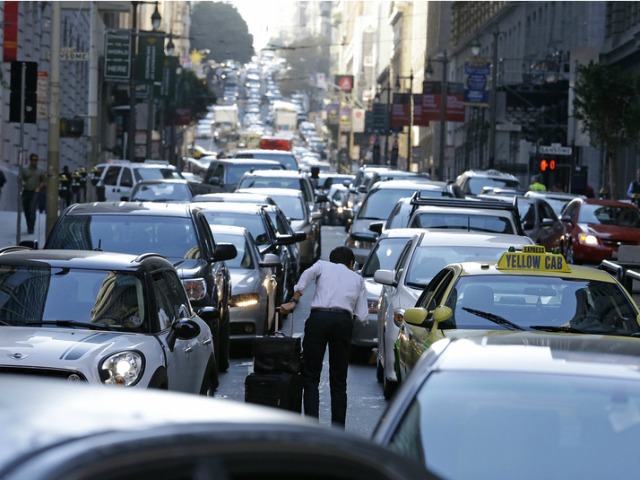
The Obama White House is preparing the ground for a late-summer fight with the GOP over the “highway trust fund” and infrastructure spending. In the next month or so, the federal “highway trust fund,” effectively, will temporarily run out of money. The media will likely inflate this into a “crisis” and finger it as the culprit for bad economic news. This coming attraction, though, is based on three major myths.
Myth #1: Without an increase in federal spending, infrastructure spending will dry up.
Most infrastructure spending is financed by state and local government. The federal government provides just under one-third of the spending. Even if the federal government were forced to reduce its assistance to state governments (more on that later), total infrastructure spending has been increasing rapidly in the last three years. In the last fiscal year, federal spending to the states increased by 7.5%. Overall, infrastructure spending is 30% higher than it was prior to the recession.
Spinning a worst-case scenario, Transportation Secretary Anthony Foxx has warned that states would experience a 28% cut in federal support if the funding for the trust fund isn’t extended. Assuming this is true, the cut would lower overall transportation spending in the US by less than 10%. One analysis by the Heritage Foundation puts the reduction as low as 7%. Even with that cut, though, infrastructure spending would be more than it was just a few years ago. This is hardly a crisis.
Myth #2: Infrastructure spending builds the “roads and bridges” critical to our economic growth.
“Roads and bridges” is the first and last talking point of any Obama economic speech. Good “roads and bridges,” to be sure, are necessary for the smooth movement of goods and services in the economy. This important category, though, is an increasingly smaller amount of total infrastructure spending in the US. Every year, more spending is diverted away from the very items that most people associate with infrastructure.
In the most recent highway bill, 17% of federal spending is diverted to mass transit, even though this accounts for just over 1% of the nation’s surface travel. Other feel-good priorities like bike paths, parkways and green initiatives combine with transit to claim 25% of federal infrastructure spending. These initiatives may look good in press releases, but they do nothing to improve the nation’s highway system.
The most recent study of highway congestion found that drivers in the nation’s 15 largest urban areas experienced 51 hours of traffic congestion in 2012, more than double the amount thirty years ago. In that same time, travel on transit systems fell by a quarter in urban areas.
Obama is actually right that building more “roads and bridges” would help the economy. Let’s try it.
Myth #3: The “Highway Trust Fund” faces a revenue crisis unless Congress acts.
The federal “highway trust fund” is financed primarily by the 18.4 percent federal excise tax on gasoline. Those funds peaked in 2006 and have been declining, relatively speaking, since then. Partly this is due to the downturn in the economy, but a large share of the decline is due to the increased fuel-efficiency of the nation’s cars and trucks. With better gas mileage, the government collects fewer taxes per mile traveled. To continue increasing federal infrastructure spending, Congress has been bridging the gap between these revenues and spending by tapping into the general fund. Since 2008, Congress has pumped an additional $50 billion into infrastructure spending.
It is this additional spending that will end this summer unless Congress provides another transfer from the general treasury. Any shortfall would impact future projects, not those currently in construction, betraying any claims that infrastructure spending would suddenly stop without a deal.
The perception of a “crisis” does give us a chance to begin rethinking how be finance infrastructure in this country. Many advocates are clamoring for an increase in the federal gas tax, which, proponents note, hasn’t been raised since 1993. (As if tax rates have a “fresh-by” date that needs regular hikes.) The CBO estimates that a one-cent increase in the gas tax would generate about $1.5 billion a year. The CBO also estimates, though, that in 10 years, bridging the revenue and spending gap will require an additional $18 billion a year. This would require a 12-cent hike in the gas tax, an almost 70% increase that is only feasible in a political fantasy-land.
Eliminating the spending diversions from the highway trust fund would alone save more than $12 billion a year. Repealing Davis-Bacon laws, which require construction projects to pay union-level wages even if unions aren’t involved, would reduce construction spending by 10%. Repealing this federal special interest mandate alone would free up around $10 billion a year for more construction.
The existential problem with dealing with federal fiscal challenges is that everyone’s starting point, Democrats and many Republicans, is the specific manner in which a function is currently being done. Any reforms are duct-taped together at the far margins, with almost no thought to whether a goal an be met another way. In this world, the gap between desired spending and revenue is, itself, the only problem that needs to be fixed.
A better, more sustained, approach is to ask whether the current spending regime is the best way to achieve the goal of better infrastructure. That effort requires more than speeches and photo-ops, but it offers the chance to get a lot further down the road.

COMMENTS
Please let us know if you're having issues with commenting.